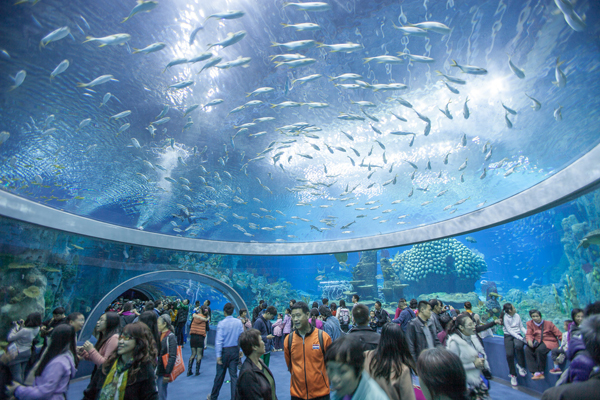Aquariums are marvels of engineering and design, bringing the ocean's beauty to land for education, conservation, and sheer wonder. Among the many aquariums worldwide, the title of the "biggest fish tank in the world" captivates both enthusiasts and casual visitors alike. This article delves into the details of the largest aquariums, their incredible features, and the marine life they house, while exploring their impact on conservation and tourism.

The title for the biggest fish tank often changes due to advancements in technology and new constructions. Currently, the Chimelong Ocean Kingdom in China holds the Guinness World Record for the largest aquarium.
Volume: 12.87 million gallons (48.75 million liters)
Key Features:
Houses the world's largest single tank.
Includes a 39-foot-high (11.8 meters) acrylic viewing panel.
Home to whale sharks, manta rays, and thousands of other marine species.
Other major contenders include:
Georgia Aquarium (USA): Famous for its 6.3 million gallons of water and a massive collection of whale sharks.
S.E.A. Aquarium (Singapore): Holds more than 12 million gallons across its exhibits.
Okinawa Churaumi Aquarium (Japan): Known for its "Kuroshio Sea" tank, housing massive manta rays and whale sharks.
Dubai Aquarium and Underwater Zoo (UAE): Features a massive 2.64-million-gallon tank with a walk-through tunnel.
Creating these massive structures requires groundbreaking engineering and state-of-the-art technology:
Tank Dimensions and Acrylic Panels:
The largest tanks have viewing windows that weigh thousands of tons, providing clear views while withstanding immense water pressure.
Filtration Systems:
Advanced systems filter millions of gallons of water daily to maintain optimal conditions for marine life.
Underwater Tunnels:
Popular attractions like the tunnels in Dubai Aquarium and Chimelong Ocean Kingdom immerse visitors in 360-degree marine environments.
These aquariums are home to a wide range of marine creatures, often including rare and endangered species:
Whale Sharks: The largest fish species, featured prominently in Georgia Aquarium and Okinawa Churaumi Aquarium.
Sharks and Rays: Hammerhead sharks, tiger sharks, and manta rays often steal the spotlight.
Coral Reefs: Many aquariums recreate vibrant coral reef ecosystems, complete with clownfish, seahorses, and reef sharks.
Rare Species: S.E.A. Aquarium houses fascinating creatures like the giant Pacific octopus and Napoleon wrasse.
A visit to one of these aquariums is more than just a chance to see marine life—it’s an immersive experience:
Interactive Exhibits: Touch tanks, feeding sessions, and behind-the-scenes tours engage visitors of all ages.
Educational Programs: Many aquariums offer workshops, talks, and interactive learning for students and families.
Iconic Features: The world's largest viewing panels, such as the one at Chimelong Ocean Kingdom, provide unforgettable sights.
Family-Friendly Activities: Kids and adults alike can enjoy themed zones, diving shows, and 4D theaters.
While the biggest aquariums focus on volume, others compete for depth:
Deepest Aquarium Tanks: The Deep Spot in Poland and Y-40 Deep Joy in Italy are specialized for diving rather than marine displays.
Largest by Water Volume: Chimelong Ocean Kingdom and Georgia Aquarium lead the way for marine exhibits.
Modern aquariums play a critical role in marine conservation:
Captive Breeding Programs: Help endangered species reproduce in safe environments.
Rescue and Rehabilitation: Facilities like Georgia Aquarium actively rescue and rehabilitate marine animals.
Education and Awareness: Programs teach visitors about protecting ocean ecosystems and reducing pollution.
Sustainability Efforts: Many aquariums invest in sustainable practices, such as energy-efficient lighting and water recycling systems.
In 2023, Japan began releasing treated nuclear wastewater from the Fukushima disaster into the Pacific Ocean. This decision sparked significant concerns about its impact on marine life and aquariums globally:
Radiation Concerns: Trace amounts of tritium may accumulate in marine organisms, affecting ecosystems and food chains.
Public Trust: Many consumers are wary of seafood and marine products from affected regions.
Aquariums’ Response: Some aquariums emphasize sourcing marine life from unaffected areas to reassure visitors.
While experts claim the wastewater is diluted to safe levels, the long-term effects remain uncertain, prompting ongoing monitoring and research.
The largest aquariums are not just scientific marvels but also major tourist destinations:
Georgia Aquarium: Located in Atlanta, it attracts millions annually for its massive whale shark exhibit.
Chimelong Ocean Kingdom: Combines marine exhibits with a theme park for a complete family experience.
Dubai Mall Aquarium: A luxury shopping and entertainment hub featuring a giant underwater zoo.
Okinawa Churaumi Aquarium: Offers a cultural glimpse into Japan’s relationship with the sea.
The world’s largest aquariums are more than architectural achievements; they are windows into the mysteries of the ocean. They inspire awe, educate the public, and contribute to marine conservation. Whether you’re admiring whale sharks in Georgia or walking through the breathtaking tunnel in Dubai, these aquariums offer unforgettable experiences.
As environmental concerns like Japan's nuclear wastewater emerge, the role of aquariums in promoting sustainable practices and awareness becomes even more vital. The next time you visit one of these marvels, remember the immense effort that goes into creating and maintaining these gateways to the ocean’s wonders.
animal tags: Fish-Tank
We created this article in conjunction with AI technology, then made sure it was fact-checked and edited by a Animals Top editor.